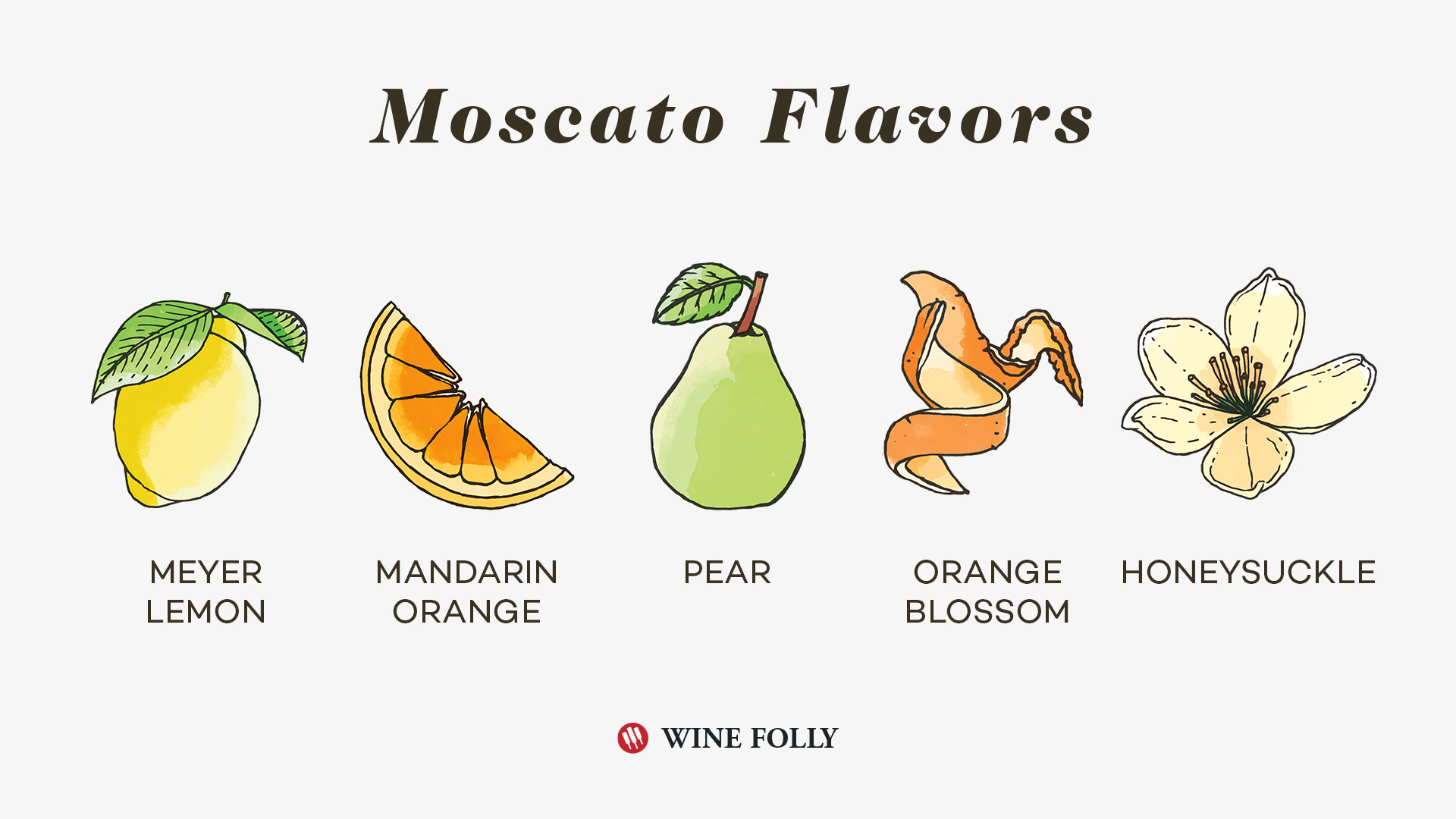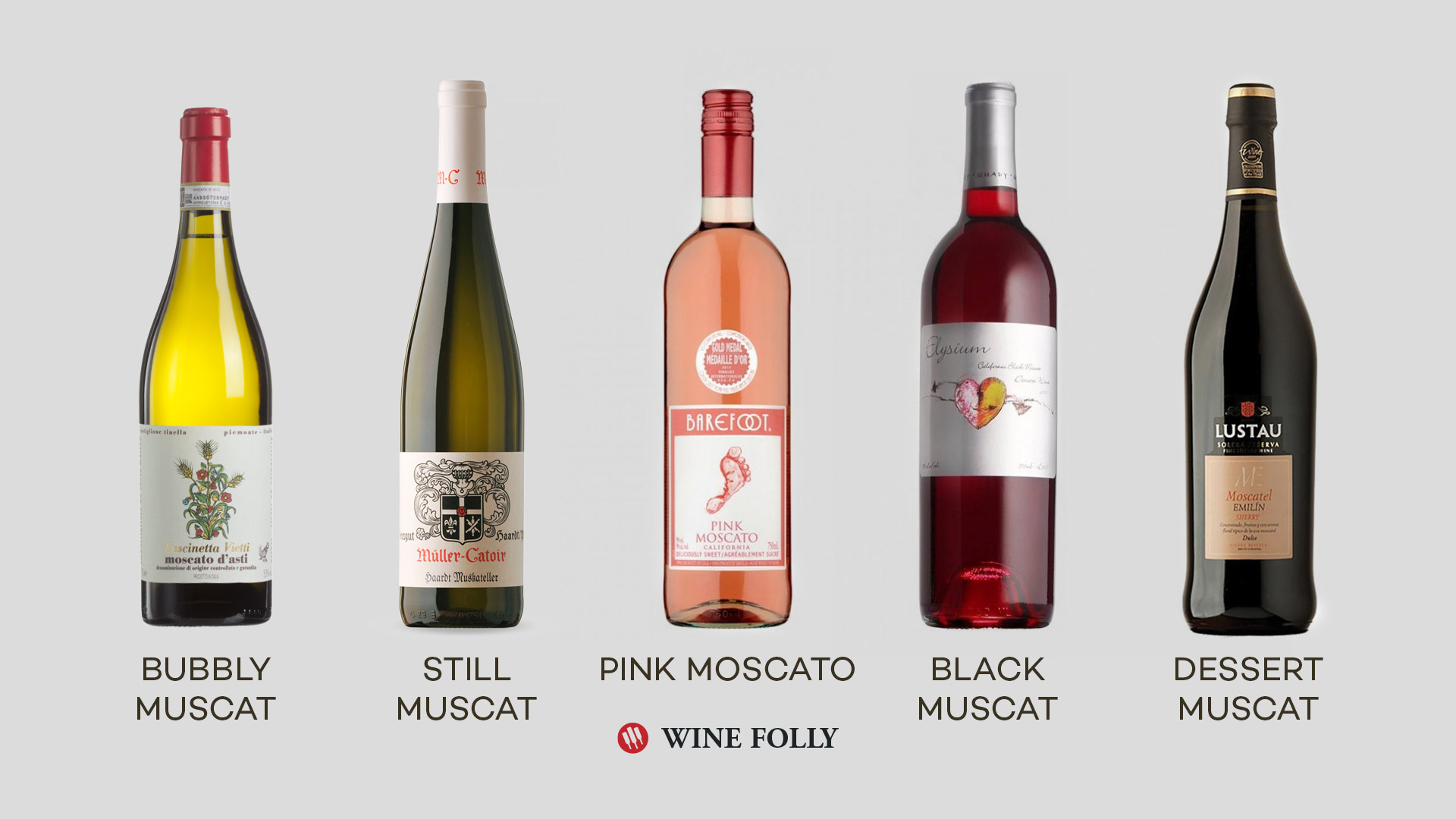What is Moscato Wine?
Moscato wine is famous for its sweet flavors of peaches and orange blossom. The word Moscato (“moe-ska-toe”) is the Italian name for Muscat Blanc – one of the oldest wine grapes in the world! So, lets find out more about this fascinating wine.
NOTE: Moscato is made with Muscat Blanc grapes.
Moscato Flavors
One of the most popular Moscato wine styles is based on the Italian wine called Moscato d’Asti from Piedmont.
Wines have perfumed aromas of mandarin orange, ripe pear, sweet meyer lemon, orange blossom, and honeysuckle. The wine’s unique floral aroma is from an aromatic compound called linalool which is also found in mint, citrus flowers, and cinnamon.
Moscato d’Asti tastes light-bodied and sweet, with tropical fruit flavors, light bubbles (the Italians call this frizzante – “frizz-ont-tay”), and low alcohol at around 5.5% ABV (btw, regular wine has about 13% ABV).
Moscato Wine Styles
Muscat grapes are quite old (thousands of years!) and thus, you can find it growing throughout the world. For example, there are Muscat-based wines in France, Italy, Austria, Greece, Israel and even Australia. Each region has a its own style. Here are the most well-known Moscato styles:
-
Sparkling and Semi-Sparkling Moscato
The Italian wines of Moscato d’Asti (semi-sparkling) and Asti Spumante (sparkling) are the classic examples, but you’ll discover wines labeled “Moscato” are typically made in this style. Both of the Italian versions have Italy’s highest DOCG classification, which means they have a protected guarantee of origin much like Parmigiano-Reggiano. The best wines are highly aromatic and sweet, but perfectly balanced with zippy acidity, bubbles, and a clean, minerally finish. This might just be the perfect pool party wine.
-
Still Moscato
Still (as in not sparkling) versions of Moscato are made with Muscat Blanc grapes but also other Muscat varieties, like Muscat of Alexandria. Two wines worth checking out include Moscatel from Spain and Muskateller from Austria. Wines are often dry to taste, but since the aromatics are so sweet and fruity your brain tricks you into thinking they’re sweet. They’re awesome, especially if you’re counting carbs.
-
Pink Moscato
Pink Moscato is more of a marketing schtick than it is a classic Moscato wine style – even though it can be tasty! This wine is made with mostly Muscat grapes and usually dollup of Merlot to give it a ruby-pink color. Imagine the classic Moscato flavors with a touch of strawberry. If you love pink Moscato, you should definitely check out Brachetto d’Acqui.
-
Red Moscato (aka Black Muscat)
It’s rare, but there’s a grape variety called Black Muscat. Imagine raspberry, rose petals and violets, with subtle roasted notes of assam black tea. The grape is a cross made from a rare Italian red grape called Schiava (wowsa) and Muscat of Alexandria. The United States has several good producers of Black Muscat worth checking out.
-
Moscato Dessert Wines
Even sweeter than Moscato d’Asti are the dessert wines. There are many to try: French Muscat de Rivesaltes and Muscat de Beaumes de Venise; In southern Spain, there is a special Moscatel Sherry with rich with caramel flavors; in southern Portugal, Moscatel de Setúbal is made with the rare Moscatel Roxo grapes; In Greece, Muscat of Samos comes in a variety of sweet styles; in Sicily, Muscat grapes are often partially dried to concentrate the sweetness; in Australia, Rutherglen Muscat is one of the sweetest styles in the world – so sweet, you could pour it over ice cream!
Calories in Moscato Moscato d’Asti ranges from 110-170 calories per 6 oz serving. Some of these calories are carbs from the grape sugars.

Moscato Food Pairing
Two words: “Asian Food”. If I had to choose just one wine for pairing with sichuan, Thai and Vietnamese cuisine, it’d be Moscato. It handles spicy foods with grace since alcohol levels tend to be low and sweetness tends to be high. Moscato loves aromatic spices like ginger, cinnamon, cardamom and chile peppers. For proteins, try lighter meats like chicken and light flaky fish. That said, a sparkling Moscato would match with BBQ Pork just as well as an ice cold Coke.
-
Meat Pairings
Chicken, Turkey, Duck, Light Flaky Fish, Pork Tenderloin, Shrimp, Crab, Lobster, Halibut, Cod, BBQ Pork
-
Spices and Herbs
Cinnamon, Ginger, Galangal, Basil, Lime, Mint, Cardamom, Chili Peppers, Cayenne Pepper, Clove, Shallots, BBQ Sauce, Teriyaki, Sweet and Sour, Orange, Marjoram, Cashew, Peanut, Fennel, Cilantro
-
Cheese Pairings
Medium to firm cheeses will pair excellently. Look for sheep and cow’s milk cheeses
-
Vegetables (and Vegetarian Fare)
Carrots, Celery, Fennel, Tofu, Red and Yellow Bell Pepper, Mango, Pineapple, Orange, Green Onion



